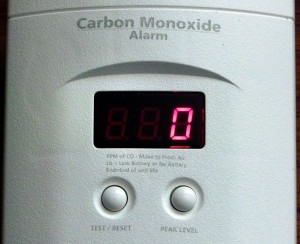By The Metric Maven
One Autumn night I was awoken at 2:00 AM by the shrill report of the carbon monoxide (CO) detector in my bedroom. I was slightly concerned, but mostly annoyed. This CO detector (and another identical unit) had been prone to setting off their alarm even when I suspected nothing was wrong. When I had a new water heater installed a few years back, the company gave me a new CO detector for my basement. I gladly replaced the CO detector that cried wolf with the new unit. So far it has never sounded an alarm. What I dislike about both units is they have no units displayed. They either shriek or don’t shriek. I determined that, if possible, I was going to purchase a new CO detector which provides measurement information. I found a new CO detector, and it indicated that it has a readout, in parts per million (PPM).
The instructions indicated that a low level of CO is 0 to 50 PPM, a mid level of CO is 50 to 100 PPM, and a high level of CO is above 100 PPM. The detector alarm sounds above 100 PPM. These are all nicely defined values, but I’ve never been sure about parts per million as a “unit.” I assume parts per million of carbon monoxide is the number of parts of CO in a million parts of other stuff. It seems like it’s telling me something, but not quite. I recall a late friend who was a political cartoonist expressed great concern to me that a toxic substance had been found in biscuit mix in parts per billion. I wasn’t sure what to think, a billion is a very big number (1 000 000 000), I wondered if this was even something of concern without any investigation, but with a simple estimate. If the Earth’s diameter (12.75 Mm) is divided by a billion, one could drop it into the cap of some ball point pens (12.75 mm). I wondered out loud if sea snake venom, or plutonium in this dilution would be deadly. It seemed like parts per trillion would be almost vanishing in their concentration.
The deadliest snake in the world is said to be the Inland Taipan which is found in Australia. When it delivers a bite (often repeatedly) it injects between 44 and 110 milligrams of venom. The median lethal dose in mice is 25 micrograms/Kg. Below is a comparison of the lethality of a sample of snakes. The units typically used are milligrams/Kg, but I used micrograms to produce integer numbers (see Naughtin’s Laws).
Inland Taipan (Australia) 25 μg/Kg
Beaded Sea Snake 164 μg/Kg
Indian Cobra 565 μg/Kg
Eastern Diamond Back Rattlesnake (North America) 11 400 μg/Kg
But what is this in parts per million?—I have no idea. Parts per million in air can be the number of grams of a substance for every million grams of mass. This is parts per million by mass. It can also be one milliliter of gas for every million milliliters of air. This is parts per million by volume. A third choice is 1 gram of gas for every million milliliters of air. This is parts per million by mass per volume. I think I feel justified at my confusion. Given the units are mass over mass milligrams/Kilogram is a factor of one million, so the LD50 values appear to be:
Inland Taipan (Australia) 0.025 PPM
Beaded Sea Snake 0.164 PPM
Indian Cobra 0.565 PPM
Eastern Diamond Back Rattlesnake (North America) 11.400 PPM
So if these doses were increased by one thousand, they would be parts per billion, and have the same values as found in the first table.
Inland Taipan (Australia) 25 PPB
Beaded Sea Snake 164 PPB
Indian Cobra 565 PPB
Eastern Diamond Back Rattlesnake (North America) 11 400 PPB
It appears that the political cartoonist was right, parts per billion can be a problem, but which parts per billion? In this case it’s parts per billion by mass. In the case of my CO detector it just states parts per million, so which PPM? I’m quite sure that “parts is parts” does not apply. Also there are two different “versions” of the words used for magnitude descriptions, which are called long and short scale.
In the case of gasses, it makes sense to have a standard temperature and pressure, and express values with metric units. This is often done with mass over a given volume which is a density. It is possible to convert 50 PPM CO to an equivalent value of 58 milligrams per cubic meter. One hundred parts per million is about 115 milligrams per cubic meter. These values are close enough that the CO levels of concern could be 0 to 50 mg/m³ for low levels, 50 to 100 mg/m³ for mid levels, and 100 mg/m³ and above for high levels of CO. I can imagine a milligram spread over a cubic meter, but an alternative could clearly be a version of grams per liter. In both cases one can visualize the quantities involved more intuitively. Milligrams are a common dosage mass for aspirin and other over the counter products.
Carbon dioxide (CO2) is a greenhouse gas, and its concentration has been measured since the late 1950s at Mauna Loa, Hawaii. The value is generally given in parts per million, which has very little meaning for me. Here is a current graph of the Keeling Curve:
The values would make a lot more sense to my intuition if the graph were in mass per cubic meter. Assuming the analysis presented here is correct, we can re-plot the monthly data (I could not find the seasonally corrected data) in terms of milligrams per cubic meter, assuming 380 ppmv is 684 mg/m³:
I can immediately estimate that the amount of CO2 per cubic meter has increased by about 100 milligrams per cubic meter since 1982 (http://spacemath.gsfc.nasa.gov/data/KeelingData.xls). The upper graph has a value of about 315 ppmv in 1960, which is approximately 567 milligrams per cubic meter. So just since measurements have been kept, the amount of CO2 in the air has increased by about 130 mg/m³. I have some intuitive understanding of this increase, and it seems like a lot!
Sulfur Dioxide (SO2) is another common pollutant. A blogger named Rei has been measuring the amount of sulfur dioxide with pollutant meters located around the Baroabunga volcano in Iceland. His blog Barobunga: “Like Being In An Enclosed Space With A Diesel Engine.” first describes human safety limits, and context levels in micrograms per cubic meter from 20 micrograms per cubic meter to the highest recorded concentration, 1000 µg/m³, taken next to Russian smelters. He observed this graph on 2014-09-10:
Rei had the reaction I would have: “could that be right?” Perhaps the equipment calibration was off?—or some other problem had occurred. After checking the equipment, it was determined that these measurements are accurate. The measured levels peaked at almost 2600 µg/m³. This plume descended on a nearby town and began to produce respiratory distress. (tip of the hat to Helen for posting a link to this article) I’ve always been doubtful about the use of parts per million, billion, trillion and so on as providing any understandable quantitative information. This article by Rei re-ignited my interest in this question.
The Wikipedia page on sulfur dioxide shows that the amount of the substance released into the air has decreased from 28.3 Megagrams in 1970 to 17.1 Mg in 1999 (the last year data is provided). Knowing the 24 hour safety limit for the World Heath Organization is 20 µg/m³ one can see that 17 Megagrams released in the the air above the US is a significant amount of pollution. One aim of this blog is to examine the clearest expression of numerical magnitudes possible to convey information in the most accessible way possible. It seems that it might be best to go with expressions which contain metric units over those which are in terms of normalized values (i.e. PPM). Determining the best method of expression in the case of CO and SO2 is not just an academic exercise, peoples lives can be lost from misinterpretation. Mass of pollutant per cubic meter of air looks like a good way to express these values, but this is a serious enough question that it should be the subject of rigorous study.
In September of 2015 Volkswagen admitted that it had rigged car emissions tests using software. This fraudulent activity affected about 11 million cars. New Scientist in a 2015-10-03 article entitled The Curious Case of NOx Pollution stated: “If this practice is widespread, it could help explain why NOx emissions in many European countries continue to overshoot targets.” The figure to the left is from the article. The limits are in micrograms per cubic meter. Perhaps the world is beginning to change and use this more accessible way of numerical expression. Unfortunately the U.S. has not embraced the metric system and abandoned its medieval units in the 21st century. If it did, we all might breath a little easier.
If you liked this essay and wish to support the work of The Metric Maven, please visit his Patreon Page and contribute. Also purchase his books about the metric system:
The first book is titled: Our Crumbling Invisible Infrastructure. It is a succinct set of essays that explain why the absence of the metric system in the US is detrimental to our personal heath and our economy. These essays are separately available for free on my website, but the book has them all in one place in print. The book may be purchased from Amazon here.

The second book is titled The Dimensions of the Cosmos. It takes the metric prefixes from yotta to Yocto and uses each metric prefix to describe a metric world. The book has a considerable number of color images to compliment the prose. It has been receiving good reviews. I think would be a great reference for US science teachers. It has a considerable number of scientific factoids and anecdotes that I believe would be of considerable educational use. It is available from Amazon here.

The third book is called Death By A Thousand Cuts, A Secret History of the Metric System in The United States. This monograph explains how we have been unable to legally deal with weights and measures in the United States from George Washington, to our current day. This book is also available on Amazon here.









